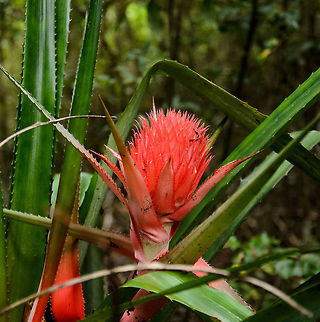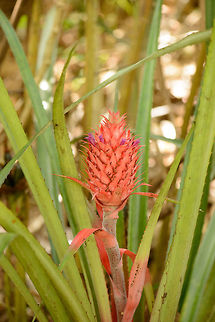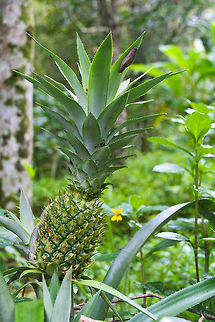
Appearance
The pineapple is a herbaceous perennial, which grows to 1.0 to 1.5 m tall on average, although sometimes it can be taller. The plant has a short, stocky stem with tough, waxy leaves. When creating its fruit, it usually produces up to 200 flowers, although some large-fruited cultivars can exceed this. Once it flowers, the individual fruits of the flowers join together to create a multiple fruit. After the first fruit is produced, side shoots are produced in the leaf axils of the main stem. These suckers may be removed for propagation, or left to produce additional fruits on the original plant. Commercially, suckers that appear around the base are cultivated. It has 30 or more narrow, fleshy, trough-shaped leaves that are 30 to 100 cm long, surrounding a thick stem; the leaves have sharp spines along the margins. In the first year of growth, the axis lengthens and thickens, bearing numerous leaves in close spirals. After 12 to 20 months, the stem grows into a spike-like inflorescence up to 15 cm long with over 100 spirally arranged, trimerous flowers, each subtended by a bract.In the wild, pineapples are pollinated primarily by hummingbirds. Certain wild pineapples are foraged and pollinated at night by bats. Under cultivation, because seed development diminishes fruit quality, pollination is performed by hand, and seeds are retained only for breeding. In Hawaii, where pineapples were cultivated and canned industrially throughout the 20th century, importation of hummingbirds was prohibited.
The ovaries develop into berries, which coalesce into a large, compact, multiple fruit. The fruit of a pineapple is usually arranged in two interlocking helices, often with 8 in one direction and 13 in the other, each being a Fibonacci number.
The pineapple carries out CAM photosynthesis, fixing carbon dioxide at night and storing it as the acid malate, then releasing it during the day aiding photosynthesis.

Naming
The first reference in English to the pineapple fruit was the 1568 translation from the French of André Thevet's "The New Found World, or Antarctike" where he refers to a, a fruit cultivated and eaten by the Tupinambá people, living near modern Rio de Janeiro, and now believed to be a pineapple. Later in the same English translation, he describes the same fruit as a "Nana made in the manner of a Pine apple", where he used another Tupi word, meaning 'excellent fruit'. This usage was adopted by many European languages and led to the plant's scientific binomial, where 'tufted' refers to the stem of the plant. Purchas, writing in English in 1613, referred to the fruit as "Ananas", but the "Oxford English Dictionary"'s first record of the word "pineapple" itself by an English writer is by Mandeville in 1714.
Habitat
Like most modern fruit production, pineapple plantations are highly industrialized operations. In Costa Rica particularly, the pineapple industry uses large amounts of insecticides to protect the crop, which have caused health problems in many workers. These workers often receive little compensation, and are mostly poor migrants, often Nicaraguan. Workers' wages also decrease every time prices are lowered overseas. In 2016, the government declared that it would be trying to improve the situation, with the help of various other groups.Historically, tropical fruit agriculture, such as for pineapples, has been concentrated in so-called "banana republics".
References:
Some text fragments are auto parsed from Wikipedia.